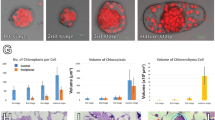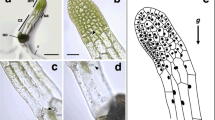Summary
The studies on the kinetics of nucleoid destruction reported here showed that destruction of chloroplast nucleoids (ct nucleoids) of male origin began to occur at about 30 minutes after mixing of male (mt−) and female (mt+) gametes. The timing of initiation of the destruction differed among zygotes but usually occurred during 50–120 minutes after mixing. About 10 minutes was required for complete digestion of the ct nucleoids. UV irradiation on young zygotes or addition of an RNA-synthesis inhibitor, actinomycin D, to the incubation medium during the first 0–30 minutes after mixing almost completely inhibited the incorporation of3H uridine into the cell nuclei and the preferential destruction without inhibiting cell nuclear fusion. These results suggest that soon after mating,de novo RNA synthesis is concerned for the preferential destruction of ct nucleoids. To determine in which of the two cell nuclei in the zygotes the RNA is synthesized, each gamete (mt−, mt+) was irradiated with UV and mated with unirradiated gametes of opposite mating type. This treatment of the male gametes had no effect on the incorporation of3H uridine into cell nuclei and the preferential destruction of ct nucleoids but UV irradiation of female gametes almost completely inhibited the incorporation of3H uridine into cell nuclei and the preferential destruction of ct nucleoids. Similar phenomena occurred in other crosses. The UV effect was photoreactivated in about 50% by white light, suggesting that the UV target is DNA. Thus, RNA synthesized in the cell nucleus of female origin soon after mating may be responsible for the preferential destruction of ct nucleoids of male origin
Similar content being viewed by others
References
Burton, W. G., Grabowy, C. T., Sager, R., 1979: Role of methylation in the modification and restriction of chloroplast DNA inChlamydomonas. Proc. Nat. Acad. Sci. U.S.A.76, 1390–1394.
—,Roberts, R. J., Myers, P. A., Sager, R., 1977: A site-specific single strand endonuclease from the eukaryoteChlamydomonas. Proc. Nat. Acad. Sci. U.S.A.74, 2687–2691.
Coleman, A. W., Maguire, M. J., 1983: Cytological detection of the basis of uniparental inheritance of plastid DNA inChlamydomonas moewusii. Curr. Genet.7, 211–218.
Gillham, N. W., 1974: Genetic analysis of the chloroplast and mitochondrial genomes. Ann. Review Genet.8, 347–391.
Kuroiwa, T., Kawano, S., Sato, C., 1983 a: Mechanisms of maternal inheritance. I. Protein synthesis involved in preferential destruction of chloroplast DNA of male origin. Proc. Japan Acad.59, 177–181.
— — —, 1983 b: Mechanisms of maternal inheritance. II. RNA synthesis involved in preferential destruction of chloroplast DNA of male origin. Proc. Japan Acad.59, 182–185.
—,Nishibayashi, S., Kawano, S., 1981: Visualization of DNA in plant mitochondria, various phages and single DNA molecule by ethidium bromide epifluorescent microscopy. Proc. XIII Inter. Bot. Cong. Sydney13, 250a.
—,Kawano, S., Nishibayashi, S., Sato, C., 1982 a: Epifluorescent microscopic evidence for maternal inheritance of chloroplast DNA. Nature298, 481–483.
— —,Sato, C., Tanaka, K., 1982 b: Preferential destruction of chloroplast nuclei from mt− parent should lead to maternal inheritance. Jap. J. Genet.57, 692.
Matsuda, Y., Tamaki, S., Tsubo, Y., 1978: Mating type specific induction of cell wall lytic factor by agglutination of gametes inChlamydomonas reinhardtii. Plant Cell Physiol.19, 1253–1261.
Ogawa, K.,Kuroiwa, T., 1984: Polymorphism of Ca++ dependent nuclease inChlamydomonas reinhardtii. Proc. the 24th Ann. Meeting of Jap. Soc. Plant Physiologists, 1984.
Sager, R., 1954: Mendelian and non-Mendelian inheritance of streptomycin resistance inChlamydomonas. Proc. Nat. Acad. Sci. U.S.A.40, 356–362.
—, 1981: The application of DNA methylation studies to the analysis of chloroplast evolution. Ann. N.Y. Acad. Sci.361, 209–218.
—,Granick, S., 1954: Nutritional control of sexuality inChlamydomonas reinhardii. J. gen. Physiol.37, 729.
—,Ramanis, Z., 1973: The mechanisms of maternal inheritance inChlamydomonas: Biochemical and genetic studies. Theor. appl. Genet.43, 101–108.
— —, 1974: Mutations that alter the transmission of chloroplast genes inChlamydomonas. Proc. Nat. Acad. Sci. U.S.A.71, 4698–4702.
—,Tsubo, Y., 1961: Genetic analysis of streptomycin resistance and dependence inChlamydomonas. Z. Vererbungsl.92, 420–438.
Sears, B. B., 1980: Disappearance of the heteroplasmic state for chloroplast markers in zygospores ofChlamydomonas reinhardtii. Plasmid3, 18–34.
Suzuki, T., Nishibayashi, S., Kuroiwa, T., Kanbe, T., Tanaka, K., 1982: Variance of ploidy inCandida albicans. J. Bacteriol.152, 893–896.
Sueoka, N., 1960: Mitotic replication of deoxyribonucleic acid inChlamydomonas reinhardtii. Proc. Nat. Acad. Sci. U.S.A.46, 83–88.
Takaiwa, F., Sugiura, M., 1980: Cloning and characterization of 4.5 S and 5 S RNA genes in tobacco chloroplasts. Gene10, 95–103.
Tsubo, Y., Matsuda, Y., 1984: Transmission of chloroplast genes in crosses betweenChlamydomonas reinhardtii diploids: Correlation with chloroplast nucleoid behavior in young zygotes. Curr. Genet.8, 223–229.
Author information
Authors and Affiliations
Rights and permissions
About this article
Cite this article
Kuroiwa, T., Nakamura, S., Sato, C. et al. Epifluorescent microscopic studies on the mechanism of preferential destruction of chloroplast nucleoids of male origin in young zygotes ofChlamydomonas reinhardtii . Protoplasma 125, 43–52 (1985). https://doi.org/10.1007/BF01297349
Received:
Accepted:
Issue Date:
DOI: https://doi.org/10.1007/BF01297349




